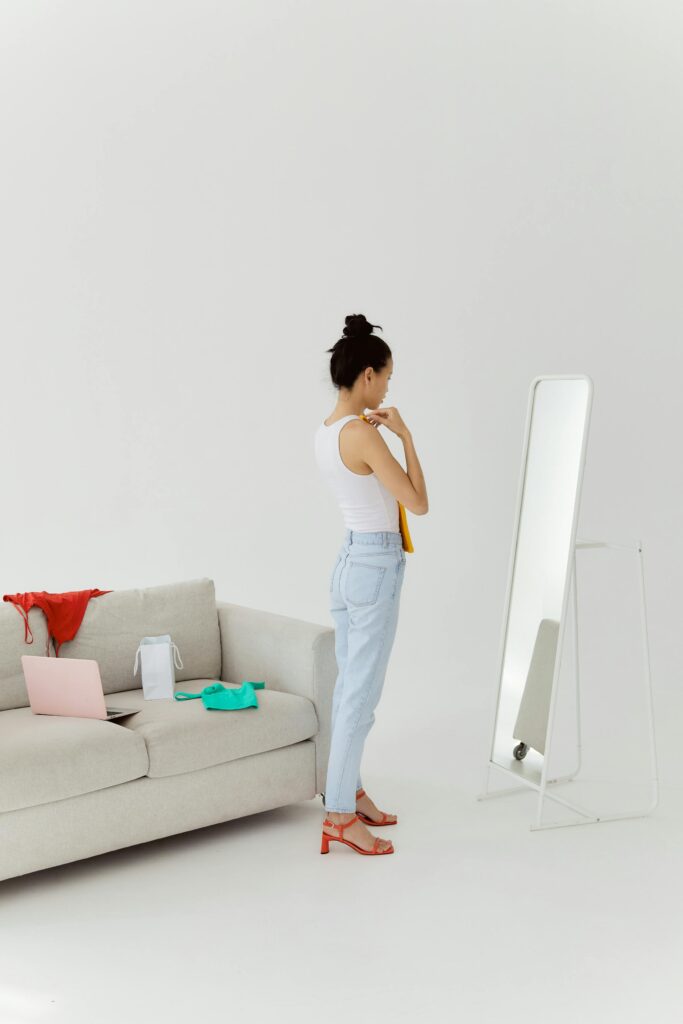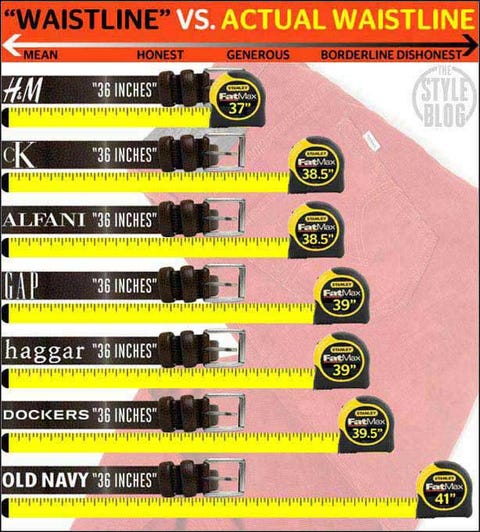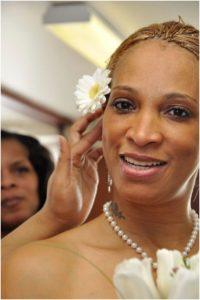
Has your pants size ever made you feel ashamed, emotional, or disgusted with yourself? You find yourself working so hard to achieve a goal, but you can’t seem to get the zipper up your dream dress? Have you ever murmured in a dressing room, "I swear this was my size! I swear I am a 12″ If you relate to any of the previous statements, you may be a victim of the fashion marketing scheme called vanity sizing.
Google defines vanity sizing as: “the practice of assigning smaller sizes to articles of manufactured clothing than is really the case, in order to encourage sales.”
Vanity sizing, a concept as intriguing as it is misleading, refers to the fashion industry's practice of assigning clothing items sizes that are smaller than their actual measurements. This tactic is designed with a singular purpose: to flatter customers into feeling better about their size, thereby nudging them towards making more purchases. It's a psychological game, where numbers on a label can dictate emotions and influence buying behavior.
In plain terms, a dress at one store can be labeled one size while the same dress could sell at a different store and be marked at a different size. If we are honest with ourselves, we know that certain stores sometimes want certain body types to wear their looks. They will then cater their supply to meet their brand and leave you stuck in the changing room thinking: “This is a medium?!”

Today, I wish to explain this system in order to undo the mental link we have as a society that our size is one static number and that this number carries our self-worth.
Vanity sizing was introduced to accommodate an increased body size in the population. I have no issue with changing a system to include and normalize more body types. Yet, somewhere a step was missed.
Today a skewed marketing system is playing off of the vulnerabilities and self-esteem of the general populous. Usually to try to sell to a targeted audience.
If they do not target this audience by adjusting the sizing, the clothes will not sell due to a lack of self-esteem in the consumer. Our self-esteem is built on such a limited framework of beauty that our moods noticeably decline when we think the number in our pants increases.
So, why should people who care about fitness, health, and wellbeing equip themselves with this knowledge of clothing sizing and trends? Because average gym-goers will measure progress at the gym by trying on an itty bitty teenie weenie yellow poke-a-dot bikini or buy a pair of new jeans.
And when the number has not changed- or worse increased, they will question their progress. As people who care about health and fitness, it is important to be acutely aware of how a client is attached to an image, weight, or size number. As a society, we have brainwashed ourselves into numbers obsession. We, especially in the media, love fixating on the idea of the perfect body. We shame, question, and occasionally celebrate when a celebrity’s size changes for what we deem “better.” (Look up Adele’s weight loss.)
Weight, BMI, calories, and dress size as numbers are calculated and used to help those who wish to maintain a healthy and happy lifestyle. That is if they use the way they are supposed to be; as tools. We, people who are into health, have a golden opportunity to take a look at what mainstream society deems “beautiful” and “normal” and unpack the language for our clients. Especially when it comes to a skewed and weighted number system such as vanity sizing.
In this Huffington Post Article, author Emily McCombs writes about Deena Shoemaker. In 2016 Deena was cleaning out her closet and noticed that her clothes, specifically pants, ranged “dramatically in size.” When she decided to post on her Facebook about the inconsistency, Deanna found out that she was not the only person struggling to understand vanity sizing. Over 57,000 people had something to say about the jumbled sizing.
If you are anything like me, vanity sizing has made shopping difficult. I fluctuate between a size 10 to 16. (yes, that big of a range). There are many factors to my clothing size, including but not exclusive to brand, diet, activity, season, cut, and fabric. To be honest, I could sneeze and my jean size could suddenly change.
What is ironic is that tailoring and sewing has nothing to do with these arbitrary numbers found on fashion labels. In my three years as a seamstress, I measured clients using a tape measure. We focused on the accuracy of our measurements in order to create well-fitting costumes that would bring a character to life. Not necessarily what the measurements said about the person.
Instead of making clothes like this, companies decide what an “average” size is to them and then create a margin of “acceptable give.” (not including fabric or elastic in the clothing). For example, You want to buy pants and your measurements are 38″ in the waist and your height is 5″6”. One company will cap their mediums between 32″-38″ in the waist and adjust their length for a person of 5’7″. While a different store will cap their jeans between 36″-40″ and adjust their leg-length for a 5’9″ curvy person with smaller thighs. Yet, both of these stores will mark these jeans as 10s.
The infographic below from Esquire (2010) compares the set company waistline to their “actual” waistline.
Pretty big difference, right?!

Vanity Sizing, in the long run, is a double edge sword. It plays into the most insecure parts of ourselves and flatters (or sometimes offends) us for profit. Due to our obsession with our bodies, companies can profit off our need to fit the standard for appearance.
In a 2013 Forbes article, author Roger Dooley states that when companies change their sizing to bigger vanity sizes (36″ labeled as a xx-large) it is shown that a client will shop there less (understandably). Meaning we have a system that places numerical values on various figures and then skews the numbers to the point that up-sizing or true sizing affects self-esteem.
In some cases, I can see the benefit of changing the sizing. I speak from an average plus-size American woman and if manufacturers went back to sizing as we did in the 1960s, my size number would increase. I will admit it makes me uncomfortable, but why? I have not changed. My body is the same, but the number assigned to it carries so much weight that we would rather have the label be smaller. I believe that the clothes label should never have changed just for profit. Instead, they should have changed for inclusion. (Some companies will upcharge an item just because it is a bigger size.) Yet instead of inclusion, we have created a “band-aid effect.” Where even if a woman feels flattered in one store, that number or size does not apply for every store. This then creates a self-esteem fashion roulette.
In fact, due to the inflation of vanity sizing, people develop an inflated idea of what size they “should” be. We have an arbitrary system in place that is discriminatory, according to The New York Times author Eliana Dockterman. The average American woman is a size 14 due to the growth as a population in the last 50 years. Yet, there seems to be a missed market for those who are fourteen in size or over. We acknowledge that people have grown larger and adjusted (to an extent) the size. Yet, as a society, we have cut off retail selling right at the American average and labeled the clothing itself smaller.
I also would like to note that I am merely talking about general standardized sizing. I am not including shape, curve, gender, fabric feel, and company policy. One of the more notorious inflation of size manipulation is Micheal Jeffries, the former CEO of Abercrombie and Fitch (a store that I have issues with, every time I go in). Jefferies, in his time as CEO, was known for “exclusionary marketing.” He openly limited shirt sizes and made the pants size cut off at 10. (10 what?!)
I don’t think we should regress to the original size charts of our grandparents. There are too many beautiful body shapes and sizes that are now celebrated to go back. I think that society has changed and thus body types have changed with it. I don’t believe that we should stick with a system that upsizes either. We have a new normal in clothing and it is a shame that we don’t embrace it more.
The convenience of online shopping comes with its own set of challenges, notably, the increased likelihood of returns due to sizing issues. Vanity sizing, with its lack of standardization, exacerbates this problem, turning what should be a straightforward process into a guessing game.
What I am merely noting is the inconsistency of the system. Shoemaker makes this point, “STOP telling my girls that a size 4 is the ‘ideal body size’ and the ‘epitome of beauty’ if you are going to change a size 4 into an 8 or a 12 or whatever number you feel like on any given day.” The weight one puts on the number on the back of a tag is arbitrary. The most important thing is to be healthy and there are other ways to measure that besides a skewed marketing system. Instead pick outfits you feel beautiful in, feel yourself get stronger with the work you put in every day.
So this week I call you to action to see if there are any numbers, images, or norms tied to fitness that you are holding on to. Why does that number/image have so much weight in your mind? Is it holding you back? Is it something you can let go of? How can you overcome expectations for the way you look and feel beautiful from the inside out?
Until next week
-Eleanor
PS: If you would like more content talking about fashion and vanity sizing I recommend YouTube’s Lady Like video series “Empty Suitcase Show.” Kristin Chirico travels to various cities with an empty suitcase to see how size inclusive that area actually is. (They have an episode in Seattle). If you are interested in having your own personal coach, we would love to hear from you and help you with the transformation that you were looking for.







DO YOU WANT TO TALK MORE ABOUT YOUR HEALTH AND FITNESS GOALS?
Enter your name and contact information below and a team member will reach out to you.
DO YOU WANT TO TALK MORE ABOUT YOUR HEALTH AND FITNESS GOALS?
Enter your name and contact information below and a team member will reach out to you.
DO YOU WANT TO TALK MORE ABOUT YOUR HEALTH AND FITNESS GOALS?
Enter your name and contact information below and a team member will reach out to you.
